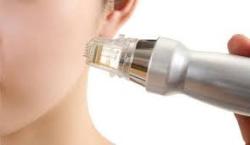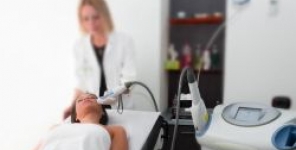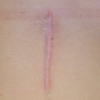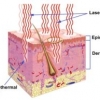Efficacia della radiofrequenza frazionata con microaghi per il trattamento dell'iperidrosi ascellare primaria: uno studio pilota
 I dispositivi a radiofrequenza frazionata con microaghi (FMR) forniscono energia al derma profondo senza danneggiare l'epidermide. Questi dispositivi FMR hanno dimostrato di essere efficaci nel trattamento delle rughe, dei pori dilatati e delle cicatrici da acne. In questo studio abbiamo voluto verificare se l'energia FMR potesse influenzano specificatamente le ghiandole sudoripare, preservando l'integrità della superficie cutanea anche quando le ghiandole sono situate nel derma profondo.
I dispositivi a radiofrequenza frazionata con microaghi (FMR) forniscono energia al derma profondo senza danneggiare l'epidermide. Questi dispositivi FMR hanno dimostrato di essere efficaci nel trattamento delle rughe, dei pori dilatati e delle cicatrici da acne. In questo studio abbiamo voluto verificare se l'energia FMR potesse influenzano specificatamente le ghiandole sudoripare, preservando l'integrità della superficie cutanea anche quando le ghiandole sono situate nel derma profondo.
Obiettivo:
Valutare l'efficacia e la sicurezza dell'FMR come trattamento dell'iperidrosi ascellare primaria (PAH) e condurre un'analisi istologica prima e dopo il trattamento.
Metodi:
Venti pazienti con PAH sono stati sottoposti a 2 sedute di FMR bipolare ad intervalli di 4 settimane. Il miglioramento clinico è stato valutato con la Scala di Severità dell'Iperidrosi (HDSS) e, inoltre, sono state scattate le fotografie del test amido-iodio ad ogni visita e dopo 2 mesi dall'ultimo trattamento. Utilizzando un Tewameter™, è stata valutata indirettamente la riduzione di secrezione sudoripara. Inoltre, sono state ottenute le biopsie cutanee da 3 pazienti prima e dopo il trattamento. A ciascuna visita di follow-up sono state registrate le reazioni avverse e la soddisfazione dei soggetti.
Risultati:
I punteggi HDSS sono diminuiti in modo significativo da un basale di 3.3, a 1.5 e 1.8 dopo il primo e il secondo mese di follow-up post-trattamento, rispettivamente (p < 0.001). Dopo 1 mese dal secondo trattamento, la valutazione soggettiva ha mostrato che il 75% dei pazienti (n = 15) aveva un punteggio HDSS di 1 o 2, mentre il 70% dei pazienti (n = 14) aveva avuto un miglioramento di oltre il 50% della sudorazione. Anche la reazione amido-iodio si era notevolmente ridotta nel 95% dei pazienti (n = 19) dopo il trattamento con FMR. Inoltre, 1 mese dopo il trattamento finale, i risultati istologici hanno mostrato una diminuzione nel numero e nelle dimensioni delle ghiandole sia apocrine che eccrine. Gli effetti collaterali sono stati minimi e hanno incluso un lieve disagio, un gonfiore transitorio e un'iperpigmentazione post- infiammatoria.
Conclusione:
Il trattamento con FMR è stato efficace per la PAH e non ha avuto le tipiche reazioni avverse del riscaldamento volumetrico diretto del derma profondo.
Storia della pubblicazione:
Titolo: Efficacy of Fractional Microneedle Radiofrequency Device in the Treatment of Primary Axillary Hyperhidrosis: A Pilot Study
Rivista: Dermatology (DOI: 10.1159/000354602)
Autori: Kim M. • Shin J.Y. • Lee J. • Kim J.Y. • Oh S.H.
Affiliazioni:
Abstract:
Background: Fractional microneedle radiofrequency (FMR) devices deliver energy to the deep dermis through insulated microneedles without destroying the epidermis. These FMR devices have been shown to be effective for the treatment of wrinkles, acne scars and large pores. In this study it was postulated that FMR energy could specifically affect the sweat glands, preserving the skin surface even if sweat glands were seated in the deep dermis. Objective: To evaluate the efficacy and safety of FMR for primary axillary hyperhidrosis (PAH) treatment and to conduct a histological analysis before and after treatment. Methods: Twenty patients with PAH had 2 sessions of bipolar FMR treatment at 4-week intervals. Clinical improvement was evaluated using a Hyperhidrosis Disease Severity Scale (HDSS) and photographs were taken using the starch- iodine test at every visit and 2 months after the last treatment. The amount of sweat reduction was indirectly assessed using a Tewameter™. Skin biopsies were obtained from 3 of the enrolled patients before and after treatment. The satisfaction and adverse reactions of the research participants were recorded at every follow-up visit. Results: HDSS scores decreased significantly from a baseline of 3.3 to 1.5 and 1.8 after the first and second months of posttreatment follow-up sessions, respectively (p < 0.001). In response to a subjective assessment at 1 month after the second treatment, 75% of patients (n = 15) had an HDSS score of 1 or 2, and 70% of patients (n = 14) expressed more than 50% improvement in their sweating. The starch- iodine reaction was also remarkably reduced in 95% of patients (n = 19) after FMR treatment. Histological findings showed a decrease in the number and size of both apocrine and eccrine glands 1 month after the final treatment. Side effects were minimal and included mild discomfort, transient swelling and postinflammatory hyperpigmentation. Conclusion: FMR treatment was effective for the treatment of PAH without significant adverse reactions due to direct volumetric heating of the lower dermis.





